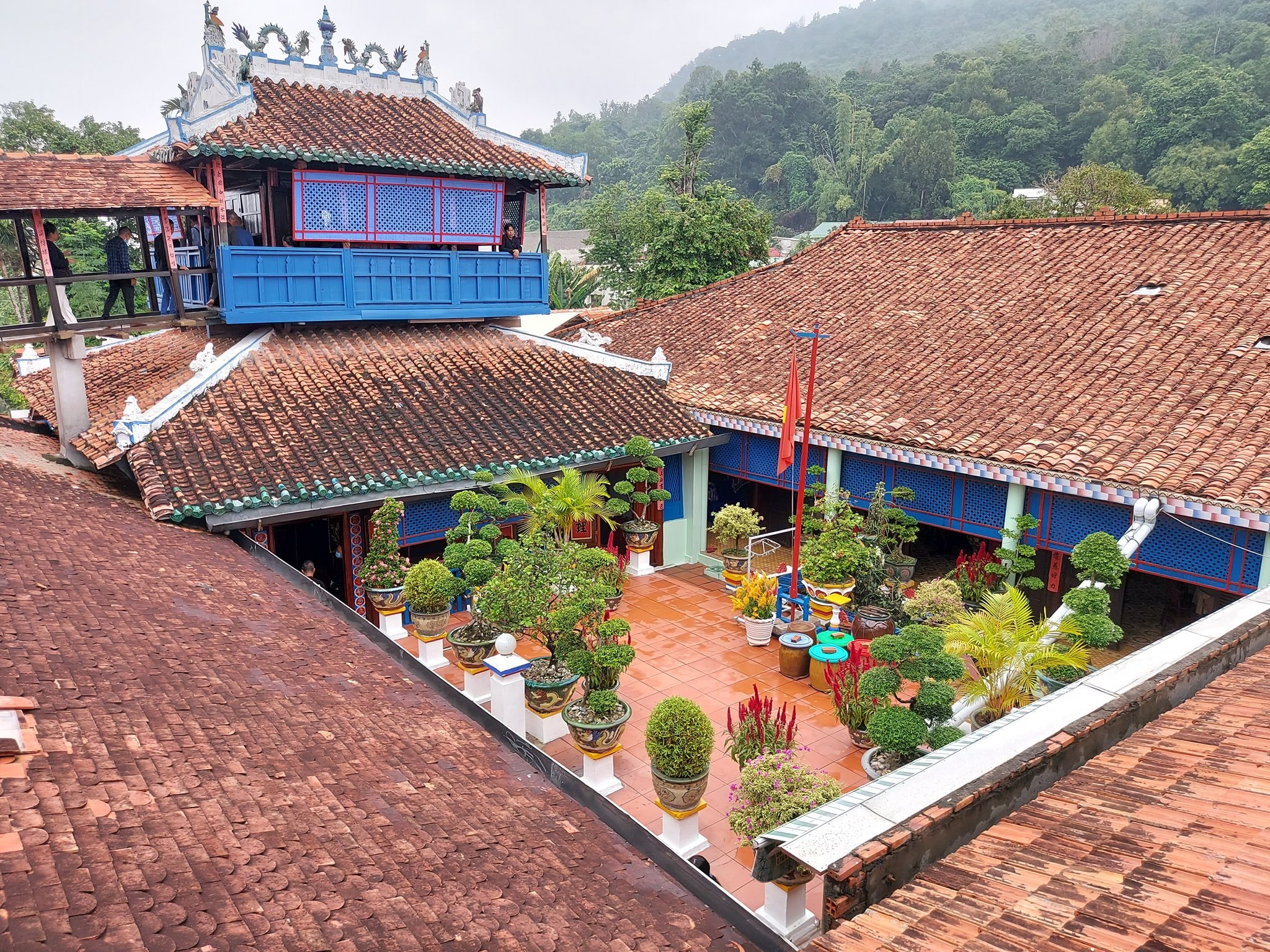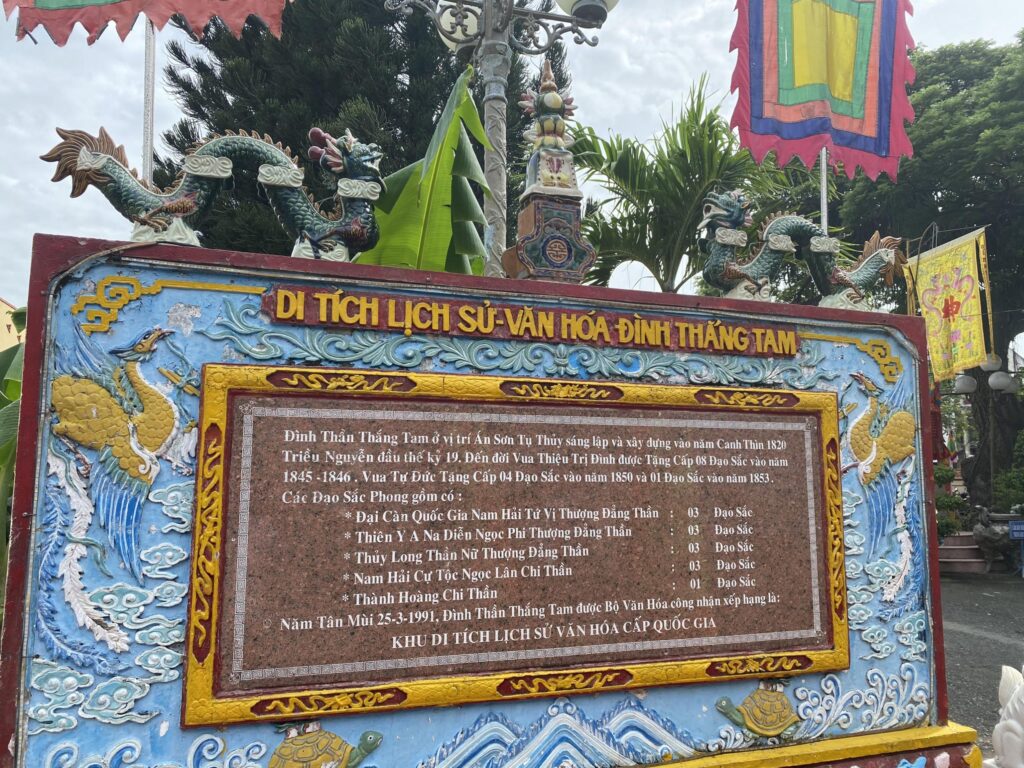Long Son Great House
The Long Sơn Great House is a religious and cultural complex dedicated to the worship of Confucius and the teachings of Confucianism. The Main Hall (Chánh Điện) was the first structure to be built, followed by the Heaven Pavilion, the Immortal Pavilion, the Buddha Pavilion, the Forbidden Pavilion, guest houses, gardens, and the three-entrance ceremonial gate.
After completing the worship area, the founder continued building the Long Pavilion as accommodation for visitors, then five rows of houses for new settlers, a school for teaching quốc ngữ (Romanized Vietnamese), and many essential communal structures such as a market, rice mill, grain warehouse, power house, carpentry workshop, kitchen, and freshwater reservoirs. Since these facilities were contained within a single compound, locals began referring to it as “Nhà Lớn” (the Great House). After his passing, the site also became known as the Temple of Master Trần.
The architecture of Long Sơn Great House blends Vietnamese folk beliefs (Heaven–Earth worship) with Confucian and Taoist elements. Most primary furnishings are made from precious xa cừ timber and inlaid with mother-of-pearl. The Great House also preserves valuable antiques, including altars, incense burners, bronze lamps, lacquered panels, and ancestral couplets—items collected by the founder during profitable trading trips from Saigon.
Confucian worship focuses not on incense or rituals but on the teachings of morality, education, and personal cultivation. Visitors are welcomed to explore the complex free of charge, and can even enjoy complimentary local treats such as cassava and bánh ít trần. Photography is allowed, except within sacred altars and the Main Hall.
After Master Trần’s passing, a new belief system—Đạo Ông Trần (the Way of Master Trần)—developed alongside Confucianism. Blending multiple spiritual traditions, it emphasizes living according to truth, goodness, and beauty. Descendants continue to preserve his customs: wearing traditional black bà ba garments, walking barefoot, keeping long hair tied neatly, and maintaining the gentle Southern Vietnamese character he embodied.
Visitors to Long Sơn Island should not miss this historical and spiritual site to better understand the Way of Master Trần and the cultural heritage of the island community.

A Legend of the Pioneer Who Founded Long Sơn
We visited Long Sơn Great House on a cool late-autumn afternoon and were welcomed by Ms. Lê Thị Kiềm—also known as Aunt Ba Kiềm—wearing a traditional black bà ba outfit. At 74 years old, she is a fourth-generation descendant of Lê Văn Mưu, the pioneer who reclaimed and founded Long Sơn Island.
According to her account, Master Trần (born Lê Văn Mưu) originally came from Thiên Khánh Village (now Tân Khánh Hòa Commune, Hà Tiên District, Kiên Giang Province). Around 1900, while fleeing French persecution for participating in an uprising, he and his companions arrived at Núi Nứa Islet (Long Sơn). At that time, the area was deserted, surrounded by mangrove forests, wild animals, harsh weather, scarce freshwater, and limited cultivable land. However, recognizing its harmonious feng shui of mountains and sea, he decided to settle.
Under his leadership, the newcomers built shelters, reclaimed land, and invited more settlers to join. This laid the foundation for the formation of today’s Long Sơn community.
Building the Great House
In 1909, Master Trần requested permission from the French administration in Bà Rịa to build a Confucian temple. After approval, he constructed the Main Sanctuary in 1910, then added the Heaven Pavilion, Immortal Pavilion, Buddha Pavilion, and expanded the existing rear hall.
By 1927, he built the Forbidden Pavilion, guest houses, ceremonial gates, flower gardens, and additional worship structures. Later, he added the Long Pavilion—providing accommodation for visitors (ground floor) and altars (upper floor). He also developed five rows of houses for new settlers, the communal house, school, market, rice mill, warehouses, carpenter house, kitchen, reservoirs, and more.
The Way of Master Trần – A Life Philosophy
Master Trần farmed rice, made salt, treated the sick with local herbal medicine, and taught a simple yet profound moral path based on humanity, propriety, righteousness, wisdom, and faithfulness. His teachings required:
- no ritualistic chanting,
- no forced vegetarianism,
- no ascetic practices,
- no superstition—
only living ethically, honoring ancestors, and helping one another.
Elder men followed his example: long hair tied neatly, barefoot, wearing black bà ba robes. As more settlers arrived from the Mekong Delta, he welcomed them without discrimination and provided land, tools, and support.
Generations have continued living by his principles:
“Do what is right. Avoid what is wrong. Obey the law. Live with kindness.”

Traditional Funeral Customs
Funeral customs in Long Sơn, based on the teachings of Master Trần, are simple, economical, and egalitarian:
- The deceased is wrapped in layers of white cloth, mat, and red cloth, without a formal coffin.
- A communal bamboo-framed burial box called “lồng liệt” is used for all citizens.
- Bodies are buried within 24 hours, without choosing auspicious hours.
- Graves are simple earth mounds without tombstones.
- The Great House provides cloth, mats, food staples, and 500,000 VND for the family.
This practice reflects the belief that all people—rich or poor—are equal in death and that the body should return naturally to the earth.
Preserving Cultural Traditions
Every 21st day of the lunar 12th month, visitors can witness master calligraphers writing liễn (red festive scrolls). Three major occasions require liễn-writing:
- Master Trần’s Commemoration Day
- Double Ninth Festival (Trùng Cửu)
- Lunar New Year (Tết)
Each year, nearly 600 scrolls in various forms are handwritten and displayed throughout the complex, carrying teachings about virtue, family values, and harmonious living.
Architecture of Long Sơn Great House
Built over nearly 20 years (1910–1929), the Great House covers more than 2 hectares and includes:
- Worship Area (Main Sanctuary, Heaven Pavilion, Immortal Pavilion, Buddha Pavilion, Forbidden Pavilion, Rear Hall)
- Tomb Area of Master Trần
- Residential and functional buildings (storehouses, communal kitchen, carpentry workshop, rice granary, power house, community residences)
The structures feature bright white walls with green wooden shutters—representing purity and the harmonious spirit of Ông Trần’s teachings.
Interior spaces hold more than:
- 33 antique altar cabinets from Hà Đông,
- collections of early 20th-century French clocks,
- lacquered and inlaid furniture,
- sacred artifacts carved with dragons, phoenixes, lotuses, and motifs of the Four Sacred Creatures and Four Seasons.
These pieces represent exceptional artistic craftsmanship spread across Vietnam.
The complex is maintained entirely by local residents and descendants of Master Trần, following a rotating system of more than 300 volunteers, five at a time, who take shifts every three days.
Group Visit & Contact Information
Long Sơn Great House (Nhà Lớn Long Sơn)
Address: Hamlet 10, Long Sơn Commune, Hồ Chí Minh City (BR–VT Region)
Representatives: 8 Community Elders (Hương chức)
Phone: 0254 384 4044 – 0913 369 874 (Ms. Kiềm)








